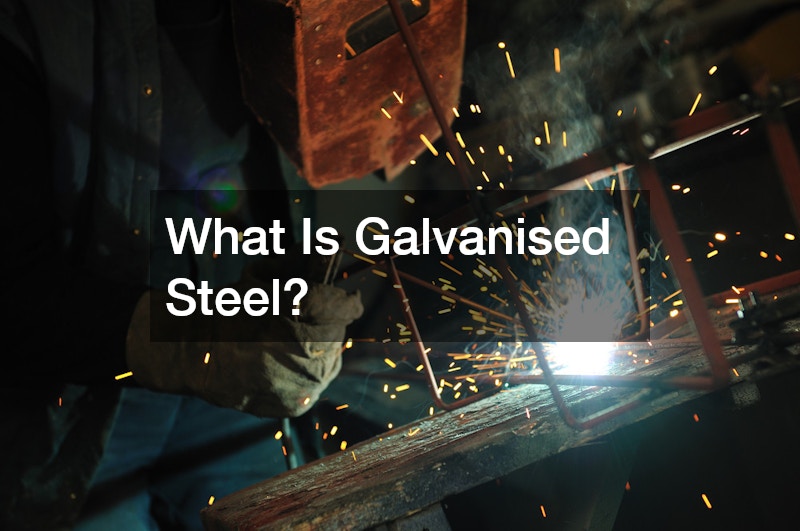Galvanised steel is one of the most widely used materials in construction, manufacturing and industrial applications. Known for its durability and resistance to corrosion, it is a top choice for projects that require strength and longevity. Whether you’re working on a large-scale infrastructure project or looking for reliable materials for fencing, roofing or structural support, finding a reputable steel supplier is essential.
In this article, we’ll explore what galvanised steel is, how it’s made, its benefits and its common uses.
What Is Galvanised Steel?
Galvanised steel is steel that has been coated with a protective layer of zinc to prevent rust and corrosion. The galvanisation process enhances the steel’s lifespan, making it suitable for outdoor and high-moisture environments.
A trusted steel supplier will offer galvanised steel in various forms, including sheets, pipes, beams and fencing materials.
The zinc coating acts as a barrier between the steel and environmental elements like water and oxygen, which can cause rust over time. This makes galvanised steel a popular choice for industries that require long-lasting, low-maintenance materials.
How Is Galvanised Steel Made?
The galvanisation process involves coating steel with a layer of zinc through one of several methods. The most common processes include:
1. Hot-Dip Galvanisation
This is the most widely used method, where the steel is submerged in a bath of molten zinc. The zinc reacts with the steel, forming a series of zinc-iron layers that provide strong protection against corrosion. A reputable steel supplier will typically offer hot-dip galvanised products for industries that require maximum durability.
2. Electro-Galvanisation
In this process, a thin layer of zinc is applied to the steel using an electric current. While this method provides a smoother finish and is often used for automotive and appliance manufacturing, it does not offer the same level of corrosion resistance as hot-dip galvanisation.
3. Pre-Galvanisation
This method is similar to hot-dip galvanisation but is performed at the steel mill before fabrication. It ensures a consistent coating but may leave cut edges exposed, making it less effective for highly corrosive environments.
No matter the method used, choosing a reliable steel supplier ensures you receive high-quality galvanised steel suited to your project’s requirements.
Benefits of Galvanised Steel
1. Corrosion Resistance
One of the main reasons industries prefer galvanised steel is its resistance to rust. The zinc coating provides a protective barrier, making it ideal for outdoor structures, marine environments and agricultural applications.
2. Low Maintenance
Unlike untreated steel, which requires regular painting or coatings to prevent rust, galvanised steel is low maintenance. Once installed, it provides long-term protection with minimal upkeep. A trusted steel supplier will offer galvanised options that reduce the need for frequent maintenance and replacement.
3. Cost-Effective
While the initial cost of galvanised steel may be slightly higher than untreated steel, it offers significant cost savings over time. Its durability and long lifespan reduce the need for repairs and replacements, making it a smart investment.
4. Strong and Durable
Galvanised steel maintains the strength of regular steel while adding an extra layer of protection. This makes it suitable for structural applications, from bridges and buildings to fencing and automotive parts.
5. Environmentally Friendly
Galvanised steel is 100% recyclable, making it an environmentally friendly choice for construction and manufacturing. By sourcing materials from a responsible steel supplier, businesses can reduce their environmental impact while benefiting from high-quality materials.
Common Uses of Galvanised Steel
1. Construction and Infrastructure
Galvanised steel is widely used in buildings, bridges and other infrastructure projects. It provides long-lasting structural support, reducing maintenance costs and increasing safety.
2. Fencing and Outdoor Structures
From residential fences to large-scale security barriers, galvanised steel is the preferred choice for outdoor structures. It withstands harsh weather conditions and resists rust, ensuring long-term durability. A reputable steel supplier can provide various fencing options to suit different needs.
3. Roofing and Gutters
Galvanised steel is commonly used in roofing sheets, gutters and downpipes. Its corrosion-resistant properties help protect homes and commercial buildings from the elements.
4. Automotive and Transport
The automotive industry relies on galvanised steel for vehicle frames, chassis components and exhaust systems. Its strength and rust resistance contribute to vehicle longevity.
5. Agricultural Equipment
Farmers use galvanised steel for equipment, silos and fencing. Its ability to withstand exposure to moisture and chemicals makes it a practical choice for agricultural applications.
Choosing the Right Steel Supplier
When sourcing galvanised steel, it’s crucial to work with a reliable steel supplier that offers high-quality products and expert advice. Consider the following factors when choosing a supplier:
- Product range – Ensure the supplier offers various galvanised steel products suited to your project.
- Quality assurance – Look for a supplier that meets Australian standards for steel manufacturing.
- Experience and expertise – A knowledgeable supplier can help you choose the right materials for your needs.
- Competitive pricing – Compare prices while ensuring you receive quality steel that meets industry standards.
Galvanised steel is a durable, cost-effective and environmentally friendly material widely used across multiple industries. Its resistance to rust and low maintenance requirements make it a preferred choice for construction, fencing, roofing and more.
Whether you’re working on a large infrastructure project or need reliable materials for home improvements, sourcing from a reputable steel supplier ensures you receive the best quality galvanised steel for your needs.
.




